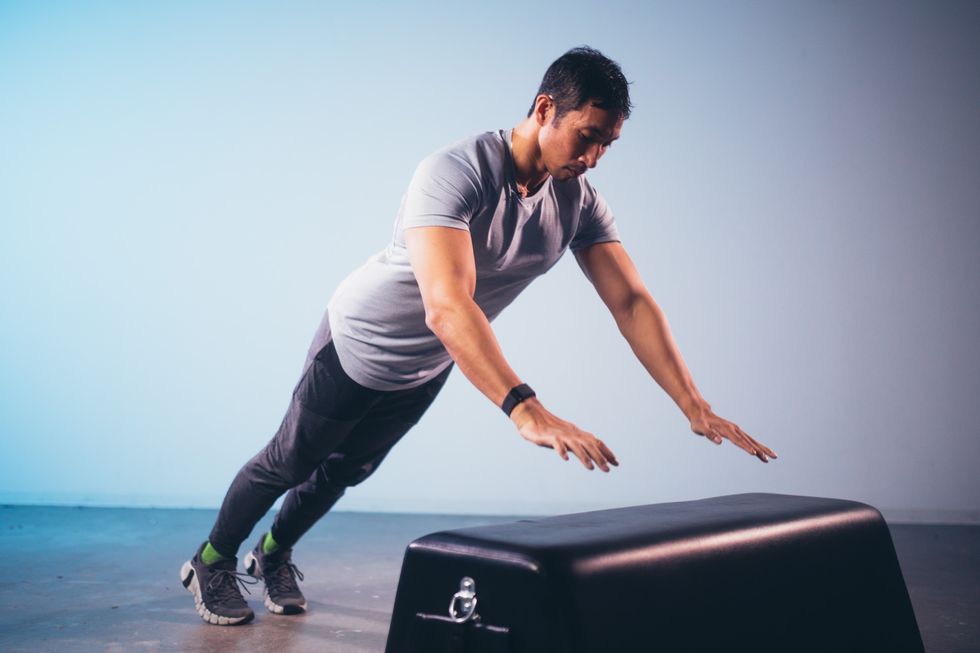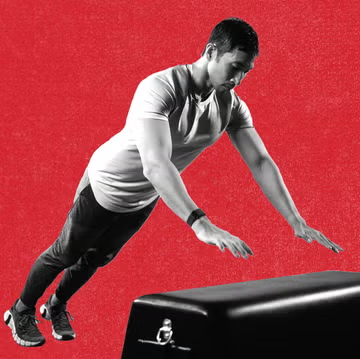MOST GUYS THINK that pushing heavy weight is the only way to build a superhero-sized chest. But you won’t be pushing yourself to your full potential—both in terms of aesthetics and function—without harnessing your explosive power. You need movements like the plyo pushup to do that.
Power is your body’s capacity to create force—i.e., the ability to push a bar away from yourself as explosively as possible. You can’t hone this ability from standard reps of your typical exercises alone. A great place to start is by incorporating some plyometric training, movements that include jumps and throws that challenge your muscles’ stretch reflex to hone power.
Unlike traditional pushups, a few explosive reps of plyo pushups—in which you will push your hands off and away from the floor—will help train your upper body to become as powerful as possible. This is a valuable characteristic inside the weight room and in real-life situations as well, according to Men’s Health fitness director Ebenezer Samuel C.S.C.S.
“We’re focusing solely on creating power, and on being explosive and being fast, three things that we want both for the overall functionality in your chest and to make us better at all of our chest exercises,” Samuel says.
Who Should Do the Plyo Pushup
Everyone
From beginners to top-level athletes, plyo pushups are a normally a safer and effective exercise to build power. The movement can easily be modified as well for any skill level (by adding a bench, for instance).
If you’re just starting, plyo pushups are perhaps going to be the most challenging exercise you’ll be performing for your chest, as the move may requires more explosive strength to separate yourself from the floor than you would normally use with free weights.
For the more advanced lifter, the way the plyo pushup hits the fast-twitch muscle fibers make for a great complementary exercise to the heavy bench presses and other movements you do for your chest.
Which Muscles Are Used for the Plyo Pushup
- Chest
- Shoulders
- Triceps
- Serratus muscle
- Core
Advertisement – Continue Reading Below
The difference between standard pushups and the plyo kind aren’t the muscles being utilized; the plyo still incorporates the chest, shoulders, triceps, etc. The difference is going to be how those muscles are trained. By adding the plyometric training element, you end up training with much more speed and force.
The plyo pushup also requires a greater focus on the serratus anterior muscles—the wing-like muscles along the rib cage. To successfully complete the plyo pushup you’ll need extra focus to how these muscles move and operate.
How to Do the Plyo Pushup
In order to work on the speed element of the plyo pushup, we need to first learn how to do these with actual speed. For beginners (and even advanced) lifters, a good starting point is to place your hands on a box or bench to initially decrease the difficulty level before progressing to the floor version. This will alleviate some early struggles, allowing you to focus solely on the speed and power elements of the plyo pushup.
- Place your hands on a box. Set up slightly away from the box, almost creating a right angle between your upper arms and torso.
- Squeeze your glutes and abs tight. Lower yourself down into the rep, keeping your elbows tight to your torso on the way down.
- Press your hands to “explode” from the bench, straightening your elbows to drive as hard as you can away from the bench.
- When your hands regain contact with the bench, slowly lower yourself in a controlled manner, then repeat.

Use the same form when you perform reps from the floor.
How to Do the Plyo Pushup in Your Workouts
The objective of the plyo pushup is to explode, not grind through a ton of reps. Keep it in the four- to six-rep range. Any more and you’ll lose that peak explosion, which is what the move is intended for.
Long story short: Your last rep should mimic your very first rep—fast and explosive.
Because plyo pushups require power and explosiveness, and those are the first things that go in your workout, it doesn’t always make a great finishing move. Unless you already have a strong upper body, keep plyo pushups near the front of your routine.











